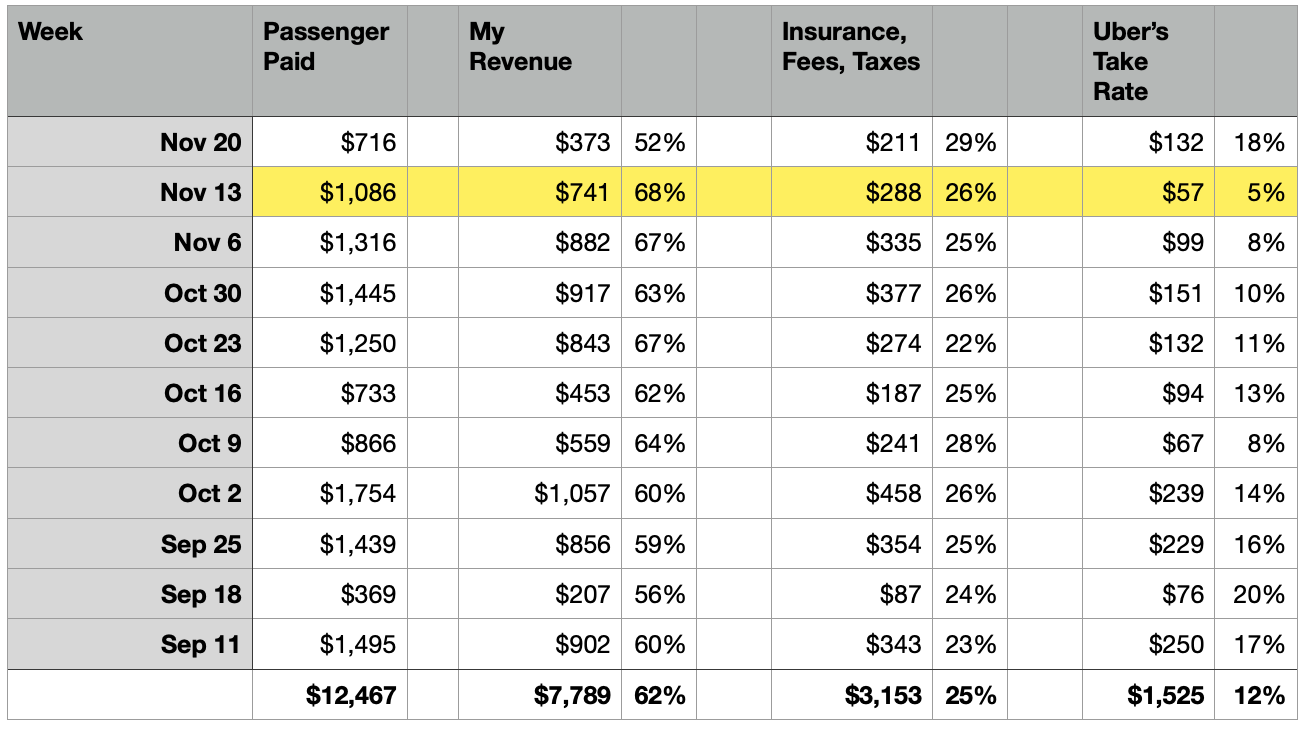Uber's Take Rate: Analyzing The Hidden Costs of Rideshare
"Uber took half of my passenger's fares." It's a common complaint from Uber drivers.
More Perfect Union released a video, How Uber Robs Its Drivers. In the video, they claim that Uber and Lyft don't tell drivers the total cost of a ride, which is patently false. I can see all the data with only a few swipes on my phone. So, let's review my data.
“Passengers paid $299.73 upfront for these trips, of which I earned $149.10, exactly half of the fare.”
I'm Levi Spires, an Uber driver in Syracuse, NY. Let me walk you through a typical day's work: On November 18, 2023, I was on the road for 8 hours, from 8 am to 4 pm, clocked 160 miles, and completed 16 trips. Passengers paid $299.73 upfront for these trips, of which I earned $149.10, exactly half of the fare. However, after accounting for fuel costs of $36.80, my gross profit stood at $112.30, or about $14.04 per hour.
Without further analysis, More Perfect Union's claim seems accurate: fares are increasing, and drivers are making less, with Uber taking half the fare.
Tipping the Scales
Interestingly, the upfront fare the passenger pays doesn't include the $43.60 in tips or trip adjustments, bringing the total passenger payment to $343.33. My earnings increased to $193.83, approximately 56% of the total amount paid by the passengers. Uber's clearly not taking half.
Adding to my revenue, Uber awarded me a $105 bonus for completing 50 trips over the weekend. With 34 trips done on Friday, the 16 trips on Saturday helped me earn an extra $33.60 ($2.10 per trip), boosting my day's total revenue to $227.43.
After tips and bonuses, I ended up earning 66% of what the passenger paid.
Clearly, Uber's Not Taking 50%, Not Even 34%
Here's a breakdown of additional expenses NOT going to Uber out of the balance:
$74.87 goes to additional insurance, tolls, and fees
$7.50 charged by the Syracuse airport for three trips
$10.95 for New York's Transportation Network Company (TNC) fee
$7.74 for the New York Black Car Fund
Altogether, $101.06, or 29% of what passengers paid, was allocated to these various fees and taxes.
Final Profit and Observations
My adjusted gross profit for the day was $190.63, leaving Uber with a gross profit of $14.84, or 4% of passenger payments. Here's a summarized view of Saturday's earnings:
$343.33: Total customer payment
$101.06: Total in insurance, tolls, and taxes
$14.84: Uber's gross margin
$227.43: My revenue
These numbers also align with my weekly statement from Uber: I earned $740.89 (68%), and Uber earned $57.15 (5%) of the $1,085.56 of the passenger payments. This isn't common, though. Since September, passengers have paid Uber $12,467, I earned $7,789, and Uber's gross margin was $1,525.
So Saturday was a good day in terms of Uber's take rate, but the fact is that Uber's take rate with me isn't 50%; it's more like 12%.
You can see all the data from this analysis here and my lifetime earnings data here.
Uber and Driver Efficiency and Pricing Dynamics
Drivers are mad at Uber for taking too much of the fare. Passengers are also mad, feeling that fares are too high. The truth is much more complex.
I estimate that the real cost to a passenger for a 5-minute, 1-mile trip in my Prius would be about $5.00. For example, on a recent trip from Syracuse Airport to downtown, I would have charged $12.58 for the 13-minute 7.8-mile trip. The customer paid $23.98, and I earned only $9.43; the rest was allocated to taxes, fees, and Uber.
Uber should be more efficient in their business model. The software is amazing! But 32,000 employees (not including customer service) is too many, and investments have hurt profits.
Drivers should also be more efficient. I drive a Prius, which costs me $0.26 per mile. But I've seen drivers in new Ram pickups, which must cost double, maybe even triple, my costs.
What About Government Mandated Costs?
Let's assume Uber and drivers are working to maximize efficiency for profitability. Fares could be cheaper, but the government isn't helping.
Insurance: Why do passengers have to pay for additional insurance? I already pay for car insurance and rideshare gap insurance. It seems like we're required to over-insure for rideshare.
Airport Taxes: Why does the Syracuse airport charge $2.50 for me to drop off a passenger? I don't pay that fee when I drive the same car to drop my wife off at the airport.
Additional Taxes: Why does New York State charge a TNC fare over and above the tolls, fuel, sales, and other taxes?
Even More Taxes: What the hell is New York's Black Car Fund? It's supposed to be for safety, but it looks more like a slush fund.
In essence, these additional costs consume 29% of what passengers pay.
Conclusion
As a driver, I believe in the rideshare model and its potential profitability. However, the increasing government-imposed expenses seem to be a significant burden on both drivers and passengers. A re-evaluation of these costs, alongside a push for greater operational efficiency from Uber and Lyft, is necessary for a more equitable and sustainable rideshare ecosystem.
*** Understanding My Costs Here's how I calculate the cost per mile: 160 miles x ($.06 fuel, $.06 maintenance, and $.11 depreciation) = $36.80 in estimated costs


